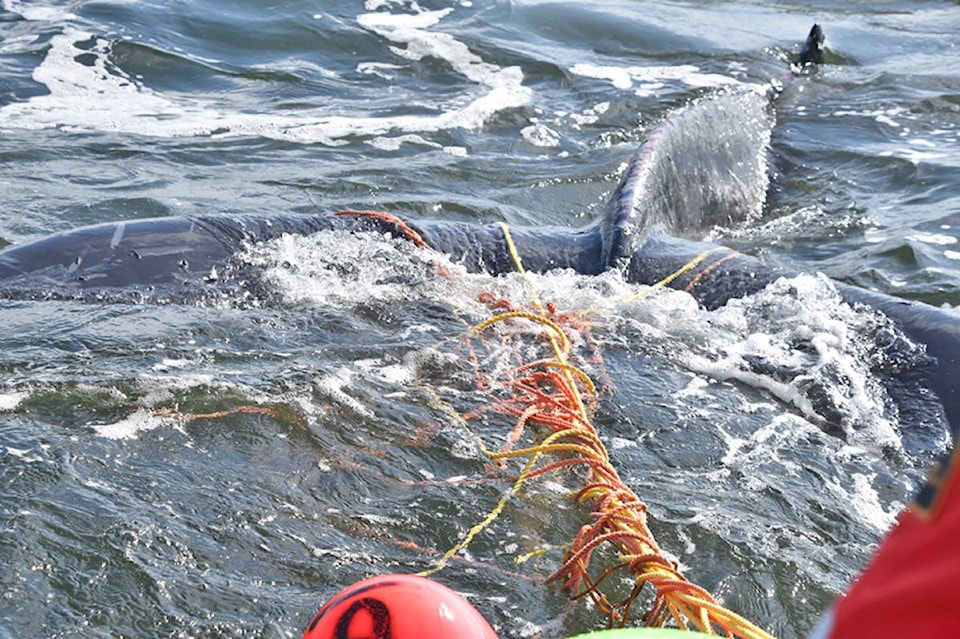A baby humpback is swimming freely once again after spending roughly four weeks entangled in prawn fishing gear.
A researcher with the Bamfield Marine Centre spotted the calf swimming with its mother near Folger Island in Barkley Sound on Sept. 9 and immediately reported it to the Department of Fisheries and Oceans Canada.
“The marine mammal rescue crew launched and spent six hours working to successfully disentangle the calf,” DFO spokesperson Lara Sloan told the Westerly News.
Within about five minutes of the report coming in, DFO Marine Mammal Coordinator Paul Cottrell was hopping on a float plane and he arrived at the scene less than two hours later, joining fishery officers to assess the situation, which looked grim.
“It basically had four wraps of rope around the head and the whole tail stock and fluke were a mass of ropes…It was just a rat’s nest. There was probably 20 wraps around the tail stock and then longitudinal with the fluke,” he said. “The calf was trumpet-blowing and showing signs of distress. It was obviously not comfortable and the ropes were already digging into both the fluke and the dorsal side. It was obviously painful for this poor calf.”
He added the rescue team had to be extra cautious because the young animal’s mother was swimming alongside, sometimes touching her calf, causing concern that she might become entangled as well or become aggressive.
“You really never know how the mom’s going to react when you’re having to get in close quarters with a calf and the calf’s in distress. It’s a highly unpredictable situation because sometimes moms can be quite aggressive,” he said. “So, this was one where we had to be extremely careful. The mom was stressed when the calf was stressed, so we had to disengage a number of times because she would do a high energy breach very close to us.”
He said the calf itself was an enormous 25-foot patient for the crew to work with and that tranquilizers are not used on whales due to concerns over dosage and potential drownings.
“These animals are massive, they’re powerful and it really is dangerous,” he said. “The mom is 45 feet long and a tremendous, powerful, animal that could create havoc if you’re not careful. It’s very nerve wracking, but yet you have to be patient, calm and collected.”
He said the six-hour rescue was full of “up and down” moments, but the end result “couldn’t have gone better,” and the calf showed high energy as it swam away after he had cut the last piece of rope off.
“The calf just took off like a shot…It’s really hard to describe the euphoria of all that effort coming together and being successful. There’s nothing like it for sure,” he said adding the calf joined its mom and swam off. “They started swimming together at the surface, which was cool to see.”
He said the crew watched the animal to confirm no entanglements remained.
“Any type of gear on an animal can kill it overtime because it works into the blubber and it can get infected and it’s just awful,” he said adding the calf suffered some superficial injuries, but will survive. “There’s going to be some scarring, but not life threatening at all…It’s great that this calf’s going to have a chance to hopefully grow up to be an adult animal that contributes to the population.”
He said the gear the calf had been wrapped up in was identified as recreational prawn gear that was set in Barkley Sound and the gear’s owner told DFO it had been missing for roughly four weeks.
“Any vertical line in the water is a potential entanglement situation,” Cottrell said adding the gear’s owner is not facing any charges as the gear was active and the entanglement accidental. “Our first pillar obviously is prevention, but if we have vertical lines in the water, we’re going to have the potential for entanglement, that’s just how it works unfortunately…We’re continually looking at that and implementing any management measures that may help.”
Surfrider Pacific Rim hosted an eight-day shoreline cleanup in the Broken Group Islands last month where 70 per cent of the debris collected came from the fishing and aquaculture industries, according to chapter manager Lilly Woodbury.
“While it’s incredible and fortunate that the Marine Mammal Rescue team was able to disentangle the humpback calf on Sept 9, it is not enough to address this issue by dealing with it reactively. We need to work together to address the root of the problem to prevent these tribulations from occurring in the first place,” Woodbury told the Westerly. “One of the ways this can be achieved is by expanding the scope of extended producer responsibility so that the manufacturers of fishing and aquaculture equipment are responsible for the entire life cycle of their products.”
Anyone who spots a marine mammal in distress must immediately report their sighting to DFO at 1-800-465-4336.
andrew.bailey@westerlynews.ca
Like us on Facebook and follow us on Twitter
READ MORE: VIDEO: Rescued eagle released in Ucluelet
READ MORE: VIDEO: Rescued fur seal released in Ucluelet
READ MORE: Sea lion shot in Ucluelet euthanized at Vancouver Aquarium
